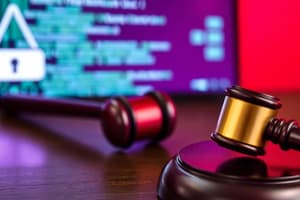Podcast
Questions and Answers
Match the following terms with their definitions:
Match the following terms with their definitions:
Cybersquatting = Registering a domain name with the intent to profit from the goodwill of a trademark belonging to someone else Illegal access = Unauthorized entry into a computer system or network Data interference = Tampering with, altering, or deleting data without authorization Privacy = The right to be left alone and control access to personal information
Match the following actions with their consequences:
Match the following actions with their consequences:
Data interference = Compromising the integrity and confidentiality of personal information Illegal access = Potential exposure of sensitive data to unauthorized parties Cybersquatting = Misleading users by impersonating a legitimate entity online Privacy = Ensuring the protection of personal data from unauthorized access
Match the following statements with the correct term:
Match the following statements with the correct term:
Data privacy = Limiting access to personal data to maintain control over its use Information Privacy = Combination of communications privacy and data privacy Cybersquatting = Exploiting domain names for financial gain at the expense of established trademarks Illegal access = Unauthorized intrusion into computer systems or networks
Match the following concepts with their significance:
Match the following concepts with their significance:
Match the following terms with their impact:
Match the following terms with their impact:
Match the following activities with their consequences:
Match the following activities with their consequences:
Match the following cybercrimes with their descriptions:
Match the following cybercrimes with their descriptions:
Match the following terms with their definitions:
Match the following terms with their definitions:
Match the following actions with their corresponding cybercrimes:
Match the following actions with their corresponding cybercrimes:
Match the following cyber threats with their definitions:
Match the following cyber threats with their definitions:
Match the following data security challenges with their descriptions:
Match the following data security challenges with their descriptions:
Match the following benefits of data security with their outcomes:
Match the following benefits of data security with their outcomes:
Flashcards are hidden until you start studying




